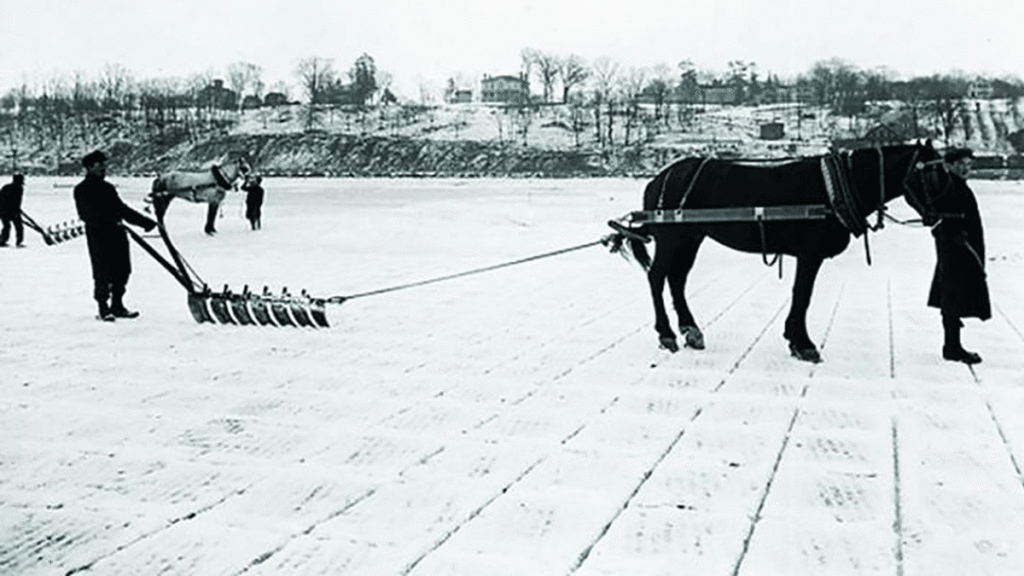
When I ponder what life might be like after peak oil, or post-TEOTWAWKI, I look back at what life was like before the automobile, before grocery stores and Wal-Farts. Life was hard. People worked long days and then worked some more. Contrary to popular survivalist belief, people DIDN’T have to live in the boonies far away from people. One could live and flourish in a city or town. In many cases, life was actually easier in a highly populated area.
Of course, 2008 isn’t 1808. There are FAR more people consuming FAR more resources. A true TEOTWAWKI situation, I think, would result in massive initial deaths as the population would be unable to adapt in such short order. Survive the initial “die off” and you’d likely find yourself living life like that in the 1800’s.
This brings me to preserving food – put it on ice! For centuries people collected big blocks of ice, hauled them to their basement or root cellar, covered them in sawdust, and used them all summer long to cool their goods. That’s cool!
This technique goes back as far as 1,000 B.C. Romans filled cellars with mountain snow. Natural-ice refrigeration was big business. I live near a large river in Maine (there are many), and I’ve seen many old, local pictures of men harvesting ice chunks from the river and shipping them off for cash!
Of course, this only lasted for a while. Read:
As cities and towns grew in both Europe and the United States during the 1800s, however, the need for mechanized refrigeration became critical. Ever-expanding amounts of food had to be transported over long distances without spoiling. Natural-ice refrigeration could not meet the need. It was also discovered that ice harvested from lakes and ponds contained microbes that caused disease. It had been previously thought that freezing killed microorganisms in the same manner as boiling.
The source is here. For this reason, one would assume that river ice is superior to lake or pond ice. The same as moving water is better than standing water if you have to drink in the wild. For this process to work again, on a community-wide scale, it’d require that initial “die off” previously mentioned.
Never mind the 1800’s, though. People are doing it to this day – in China! Check it (from ChinaDaily.com):

The people in this picture are doing the same thing our forefathers did for many years. For these people, the work is worth the savings on electrical refrigeration. Hell, I can remember, as a kid, a hermit in my hometown that lived in a nasty, run down house near a small lake. He cut ice chunks near the shore every winter, because he lived without electricity. He’d flag the entire ice cut area so snowmobiles wouldn’t take a nosedive into the lake. I can only assume he had a tractor or horse to move the blocks.
That could be a major hurdle in trying to use ice WTSHTF. Not many people keep oxen or horses anymore.

5 comments
It is also good to consider that people got their food in much smaller quanities. Think quarts of milk not 3 gallons in the fridge. Often people went to the market for the evening meals meat instead of a half a beef in the freeze.
There used to be a product called the “Icy Ball”. All that was required was a heat source of some kind. Theres various pages on the internet showing people who have made their own. An interesting project if you have the desire.
Good post RangerM
You are going to need an ice saw.
Maybe Lehmans?
My Pap kept his food fresh by being alive until he needed it…
As a kid I passed many a dinner while walking from the car up to the house.
another guest meant another chicken to be killed…there was a spring house and a cistern to keep things cool if no electric were available…it was a very small place but it was very productive…5-10 gallons of milk on hand and it was drink all you want….this was in the 1960’s . though i lived in town,all the corner store was for was to buy candy and some ice cream…We hunted at paps,we got our beef,pork,eggs,ect from Paps.
when the riots hit,we went to Paps.
I was little then,but I still remember a car on its roof burning at the end of my street. Pap showed up with a truck and we bailed . 2 uncles were standing in the back with guns and we kids were told to stay down.
I dont need to be told to prepare.
I’ve known it all my life.
Thanks for the link to me blog.
Dragon
the following is from a be list I’m on.
Excerpt : Washington Post(no link availlable).
Bollworm Evolves to Resist Toxin
In the last decade, dozens of varieties of corn, soybeans and cotton have been planted that were genetically modified to produce a bacterial protein, called Bt, that kills insect pests. Now a strain of bollworm, an insect that voraciously attacks cotton plants, has evolved that is resistant to the genetically modified plants that are supposed to kill it.
Nature is not without a sense of humor,I believe…Dragon